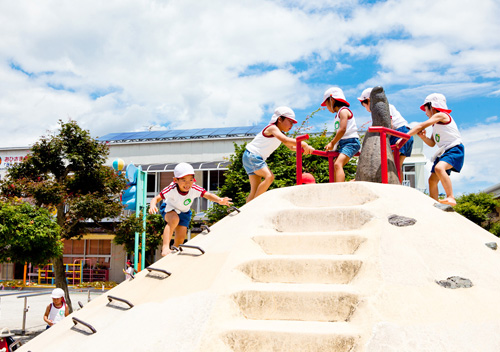
from Japan vol. 60 2012.05.28 Returning energy back to the public - The activities of Ohisama Shinpo Energy
![]()
- A land blessed by the sun
- The Zero Yen System helps give dreams wings
- Public funds create quite a sensation
- Nurturing children’s “love for science”
- An onsen ryokan that is very thorough about saving energy
- Efforts to save heat and electricity at a mushroom farm
- The spirit of “community farming” is key to being pioneers of natural energy
- Making the cash flow and hopes “visible” with social business
Japan’s energy self-sufficiency is said to be strikingly low, at a mere 4%. After the Great East Japan Earthquake and the disaster at the Fukushima Daiichi Nuclear Power Plant, many of us in Japan may have felt apprehensive about the precarious situation our lives are in – our dependence on finite resources imported from a country far far away and being a part of an enormous energy supply system that we have no control over. Iida City in Nagano Prefecture has been a true forward thinker when it comes to energy. Even before the Great East Japan Earthquake, the city has aspired to achieve local production and local consumption of energy and has actively explored ways to use nature’s blessings such as sunlight, forests, and water to generate electricity and heat. We spoke to the representative at the Ohisama Shinpo Energy, an organization that has played a central role in helping Iida City’s realize its goal.
(Photograph above provided by: Ohisama Shinpo Energy)
目次へ移動 A land blessed by the sun
Iida City is in the central area of Minami Shinshu, which is located in the southern part of Nagano Prefecture. It is a 4-hour drive from Tokyo to Iida. The total surface area of the city is a little bigger than Tokyo's 23 wards put together, but of course it is not as densely populated - Iida's population is around 105,000. The city with its river terraces is surrounded by beautiful mountain ranges of the Southern and Central Alps, so it looks picturesque from every angle.
Iida gets the highest level of sunlight in Japan - approximately 2,000 hours a year. The city is often described as a land blessed by the sun. The rapid widespread of solar power generation here in recent years has taken place in a way that is quite unique. In 2005, Ohisama Shinpo Energy began a solar power generation business financed by public investment. Since its launch, solar power generation systems have been set up in 162 locations including nursery schools, public facilities, and office buildings. With incentives like subsidies and buyback programs, solar panels will be set up in over 400 locations across Iida this year. The "Ohisama Zero Yen System" initiated in 2009 allow citizens to install solar panels for zero yen, so this system has encouraged the widespread installation of solar panels to people's homes.
After looking into the earthquake resistance and selecting the appropriate solar power manufacturer, the zero yen system helps set up solar power generation facilities in people's homes for free. Residents get electricity for 9 years as well as maintenance services, and in return pays 19,800 yen a month. After 10 years, the facilities are handed over to the residents.
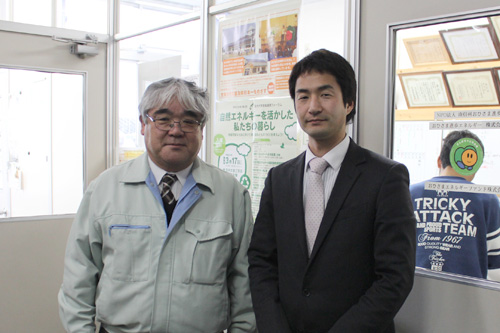 The office of Ohisama Shinpo Energy. The representative, Mr. Akihiro Hara (left) and Mr. Katsutoshi Morioka, who arranged this interview.
The office of Ohisama Shinpo Energy. The representative, Mr. Akihiro Hara (left) and Mr. Katsutoshi Morioka, who arranged this interview.
目次へ移動 The Zero Yen System helps give dreams wings
We spoke to someone who has actually had a solar power generation system installed in his home using the Zero Yen System. Mr. Masaomi Sasaki teaches children in a special needs education program at a junior high school in town. "I have always wanted to give solar power generation a go, but it takes a lot of money to install the system. The central government and the city doesn't provide enough subsidies to cover a large portion of the initial investment required, so you need to have a chunk of money to start off with. The Zero Yen System is perfect for those of us without the start-up funds. Also, new homes are earthquake resistant, but I thought that it may be difficult to install a solar power generation system if you lived in an old home, so that is another reason why I had been hesitant. But Ohisama Shimpo looked into that for me, too."
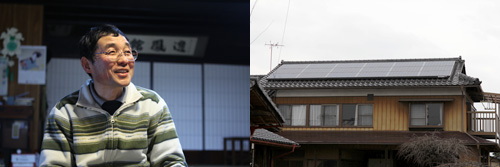 (Left) Mr. Masaomi Sasaki. I spoke to him in his 120-year old home with an earthen floor. (Right) Solar panels installed April last year (3.3KW). On aggregate, the system has generated 3,700KW as of March 4, 2012. The system continues to steadily generate energy!
(Left) Mr. Masaomi Sasaki. I spoke to him in his 120-year old home with an earthen floor. (Right) Solar panels installed April last year (3.3KW). On aggregate, the system has generated 3,700KW as of March 4, 2012. The system continues to steadily generate energy!
Mr. Sasaki has kept a record of the electricity prices issued by the Chubu Electric Power Company over the past 6 months. When asked what his electricity bill has looked like since the solar power generation system was installed he answered, "For example, in July I sold 13,000 yen and bought 6,600 yen worth of energy. I am supposed to pay 19,800 yen as a service fee (the amount of energy sold is subtracted from the service fee), but I only end up paying around 13,000 yen each month. So it seems quite economical to me." Before the installation he used to spend around 15,000 yen a month on electricity.
Mr. Sasaki said that his awareness changed after installing solar panels in his home. "You can give dreams wings in your home, too. It really was a fantastic opportunity. You start with a dream, but you end up discovering many other things you want to do. I am now quite interested in power generation using second-hand solar panels and storage batteries. There is also an irrigation channel near my home, so I wrote in the Ohisama Shinpo Energy's survey that it would be a great idea to incorporate small-scale hydroelectric generation as well."
目次へ移動 Public funds create quite a sensation
Ohisama Shinpo Energy is now a corporation, but it began as an incorporated non-profit organization, the Minami Shinshu Ohisama Shinpo. Mr. Akihiro Hara, who has played a key role in the development used to work as a salary-man in the financial industry. His awareness for energy was actually cultivated through meetings held by many volunteers from the industry, government, and academia, including his brother who was conducting combustion research at the Nagoya University, held regularly as part of the local community's activities in Iida. It was 11 years ago, when he was 51, that he decided he wanted to contribute to solving global warming issues back in his hometown and to quit work. He set up a small office, studied the demand for energy, and tried to start a business based on offering energy-saving proposals, including reducing the basic electricity rate, but in the beginning, people didn't show much understanding for what he was trying to do.
Things changed when the Ministry of the Environment launched "A Community Model Project of a Virtuous Circle for Environment and Economy" ("Heisei Mahoroba (Utopia)" Community Creation Project). And in July of the same year, Iida City, which takes pride being an eco-conscious, cultural city, adopted this large-scale subsidy program that would provide nearly 500 million yen over the course of 3 years. Mr. Hara was then asked whether he would be interested in establishing a private company that would be responsible for this program in Iida. As an incorporated NPO, Mr. Hara was already working to build a solar power plant based on donations jointly run by the public, but he and his partners established the Ohisama Shimpo Energy Co., Ltd. after he was approached with this opportunity. In order to get a business that really got the public involved up and running, he launched a program to install solar power generation systems and energy saving programs operated on funds provided by the public.
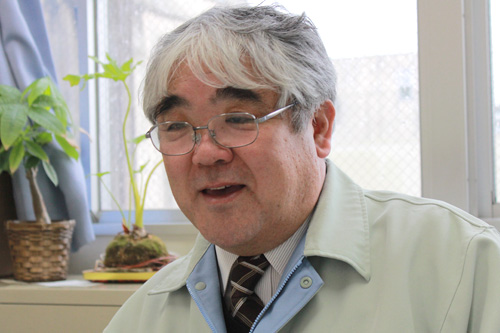 Mr. Hara describes how the public fund was established.
Mr. Hara describes how the public fund was established.
During the first year, the project required that they gather 200 million yen of investment from the public. Many people wondered, "Can you really collect that much money in Iida?" Mr. Hara explained that he, too, wasn't certain. But the staff at the Institute for Sustainable Energy Policies (ISEP), who offered substantial support when he was getting his company started, encouraged Mr. Hara, highlighting a case in Hokkaido that successfully gathered the necessary funds to install windmills. The staff at ISEP told him, "You might think that getting the public to invest means getting people in 'Iida' to invest, but that's not necessary the case. There are many people all over Japan that are interested in global warming issues." That is why he began seeking investment nationwide. Once he got started, he saw that what the people at ISEP had said was absolutely true. His public fund drew much attention, and he managed to gather 215 million yen in only 2 months. As a result, during the first year of the program he installed 208KW of solar panels to 38 locations such as nursery schools.
Looking back, Mr. Hara recalled that "the eagerness of the city's employees" was another factor for success. "I remember them getting yelled at by their boss in the beginning that this wouldn't be possible. No matter how many times they were shot down, they kept trying really hard, as though it was their own project." This public fund plans to pay back its investors in 10 or 15 years time (up to 20 years with an extension). But generating power on rooftops of government property such as nursery schools and community buildings was an unconventional use of these facilities under local legislation. There had been no precedence for long-term agreements, but if they couldn't borrow these facilities for at least 20 years, the credibility of the fund would be put at risk. The division in charge of the project and the management had many heated discussions, and in the end they received the go ahead from the mayor. Mr. Hara said that the people he fought together with to overcome these bureaucratic obstacles are still his very good friends and allies.
目次へ移動 Nurturing children's "love for science"
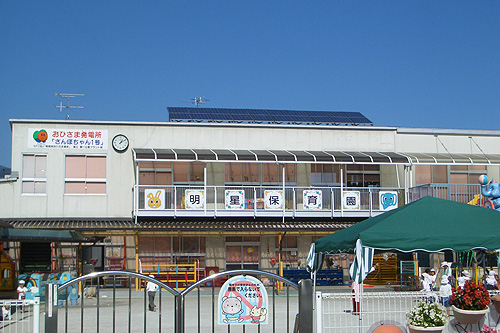 Ohisama solar power generator no.1, Myojyo Nursery School. (Photograph provided by: Ohisama Shinpo Energy).
Ohisama solar power generator no.1, Myojyo Nursery School. (Photograph provided by: Ohisama Shinpo Energy).
So far, 5 public funds have been established and each time Ohisama Shimpo has been able to gather the necessary investment without difficulties. The very first solar panel that was purchased with donations from volunteers was installed at the Myojyo Nursery School.
We spoke to some teachers at the school, the principal, Ms. Hiromi Yamauchi, and Ms. Yuki Toyama. They incorporate solar power generation in their teachings.
The school frequently communicates with parents through circulars. They have one dedicated to the environment called, "Ohisama Dayori (Sunny News)". "My child now goes around turning all the lights off in the house. Once, he even turned off the main power switch!" The school began to hear cute stories like this about children practicing eco-conscious tips they learned in school at home. They wanted to share them with other parents, so they began issuing this particular circular once a month.
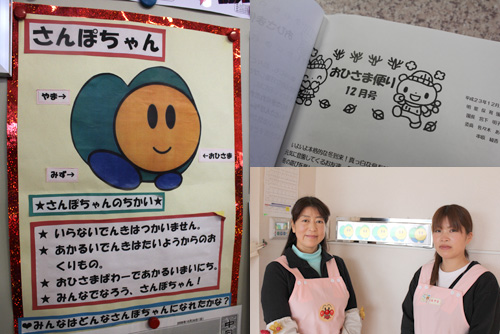 (Left) "Sanpo-chan", Ohisama Shinpo's mascot, is very popular among the children. They memorize and repeat "Sanpo-chan's promises". (Upper right) Ohisama Dayori. The circular provides information about the amount of energy generated each month and also features a quiz about nature. (Lower right) A power generation monitor with a manual switch operated by teachers. The children check the monitor every day and make observations such as "Today, there are 2 Sanpo-chans. That's how strong today's sun is." (Ms. Yamauchi is on the left, and Ms. Toyama is on the right).
(Left) "Sanpo-chan", Ohisama Shinpo's mascot, is very popular among the children. They memorize and repeat "Sanpo-chan's promises". (Upper right) Ohisama Dayori. The circular provides information about the amount of energy generated each month and also features a quiz about nature. (Lower right) A power generation monitor with a manual switch operated by teachers. The children check the monitor every day and make observations such as "Today, there are 2 Sanpo-chans. That's how strong today's sun is." (Ms. Yamauchi is on the left, and Ms. Toyama is on the right).
The school also teaches children about science. They play with small, hand-made solar cars, they heat water with the heat collected by their hand-made, speaker-shaped, aluminum solar oven. "We discovered that the love of science is not very different from what we try to teach children every day. Helping children find solutions about things they've noticed, letting them test and discover solutions for themselves. That is very much what we do every day" described Ms. Yamauchi. How amazing is it that these children are given such an opportunity to become naturally interested in science.
目次へ移動 An onsen ryokan that is very thorough about saving energy
Ohisama Shimpo Energy not only runs a program that focuses on "creating" energy, it also has a program that helps people "save energy." The energy saving program is carried out by the Energy Service Company or ESCO for short. ESCO studies the energy efficiency of its clients and develops plans that would help them reduce the amount of energy consumed, selects the optimal installation company, applies for subsidies on clients' behalf, etc.
Some clients are quite savvy about system circuits such as heat supply systems. Mr. Etsuo Kojima, the president of an onsen ryokan, Sangitei, located in Iida took us around his facilities. Mr. Kojima, whose head is always full of ideas sometimes even draws circuit diagrams himself and loves to minimize wasteful use as much as possible.
It is hard for ryokan's to cope with the rise in prices of kerosene in the winter. "So it's best to not use the kerosene boiler at all. Ours is covered in dust," said Mr. Kojima. In 2007, he applied for the Ministry of the Environment's subsidy and installed a boiler that can be run on wood. He has been able to save a significant amount of money by reusing scrap wood, which he obtains for close to nothing. The heat given off by the boiler is processed through the heat exchange system to heat the baths and supply hot water. He has developed a system that allows him to reduce the use of the kerosene boiler as much as possible.
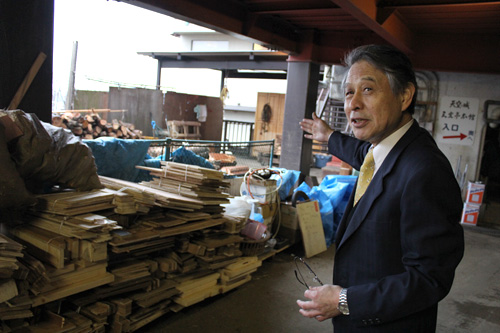 The boiler can be run on scrap wood from housing that has been separated from other wastes by the industrial waste disposal contractor. A 4-ton truck worth of scrap wood only costs 1,000 yen. President Kojima says that he goes to the boiler room 7 or 8 times a day. "I love it back there, more so than being in the reception area (laugh). So I can tell when the boiler is having a bad day."
The boiler can be run on scrap wood from housing that has been separated from other wastes by the industrial waste disposal contractor. A 4-ton truck worth of scrap wood only costs 1,000 yen. President Kojima says that he goes to the boiler room 7 or 8 times a day. "I love it back there, more so than being in the reception area (laugh). So I can tell when the boiler is having a bad day."
The following year, with the cooperation of Ohisama Shimpo, he implemented a heat pump that would recycle used onsen water. The heat pump is a device that uses heat created with the rise in pressure. The water that overflows from the baths are stored during the day in 30-ton tanks and heated over night using cheaper energy. And by exchanging the heat with the water from the wellspring stored in the 40-ton tank, the water in the 40-tank at 33 degrees can be heated to 45 degrees. This is another way that helps Mr. Kojima avoid using the kerosene boiler. The used onsen water is lukewarm to start with, so the heat pump can be applied efficiently, and all these efforts has helped Mr. Kojima reduce the amount of kerosene consumed per year down to 23.5 kiloliters.
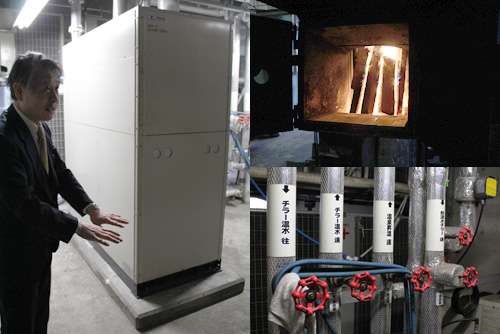 (Left) Heat pump that reuses onsen water. (Upper right) This boiler has helped reduce kerosene consumption by 82 kiloliters. (Lower right) Mr. Kojima's efforts to save energy can be seen in every corner of his ryokan. You can really see that he is quite thorough about not wasting heat.
(Left) Heat pump that reuses onsen water. (Upper right) This boiler has helped reduce kerosene consumption by 82 kiloliters. (Lower right) Mr. Kojima's efforts to save energy can be seen in every corner of his ryokan. You can really see that he is quite thorough about not wasting heat.
目次へ移動 Efforts to save heat and electricity at a mushroom farm
Next, I went to the Kamigo region where approximately 70 mushroom farmers can be found. I heard that there is a farmer there that installed a boiler back in 2005 that can be fed end-of-life brown beech mushroom beds. The energy generated is used for sterilization. Curious, I went to meet the farmer and I was shown around the facilities.
At the Sakura Farm, brown beech mushrooms are cultivated non-stop, 24-7, 365 days a year. President Toshimi Sakurai used to use kerosene boilers to sterilize culture mediums made of wood shavings and ground corncobs. To keep the boiler burning for 8 hours Mr. Sakurai needed 250-300 liters of kerosene. This process is carried out 15 times a month, so that's quite burdensome. That is why he installed a boiler that can be run on end-of-life mushroom beds.
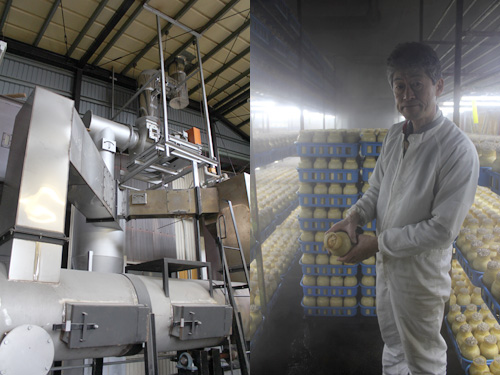 (Left) This boiler was installed as part of the energy saving project launched in 2007 by the Ministry of the Environments' "Heisei Mahoroba Community Creation Project". (Right) Mr. Toshimi Sakurai. 300,000 bottles are used 5 times each to grow brown beech mushrooms, so he ships about 1.5 million clusters a year. His mushrooms are sold in Kansai, Chukyo, and Kanto areas.
(Left) This boiler was installed as part of the energy saving project launched in 2007 by the Ministry of the Environments' "Heisei Mahoroba Community Creation Project". (Right) Mr. Toshimi Sakurai. 300,000 bottles are used 5 times each to grow brown beech mushrooms, so he ships about 1.5 million clusters a year. His mushrooms are sold in Kansai, Chukyo, and Kanto areas.
At first, the culture medium placed inside the boiler didn't burn well, so Mr. Sakurai tested various different methods. Now he only has to use kerosene in the beginning. Mr. Sakurai has been able to reduce the use of kerosene by 70%.
Moreover, at the end of December last year, Mr. Sakurai replaced 330 florescent lights with 660 LED lighting in order to rein in the energy consumption in the growing rooms. These LEDs were developed anew so that they would have improved waterproof features to withstand the harsh 90%-humidity environment of the growing rooms. The reason why he needed twice the amount of LEDs is because the light emitted by LEDs tends to travel directly downwards so in order to get the mushrooms to grow straight rather than crookedly, he needed to install LEDs evenly, on the left and right sides.
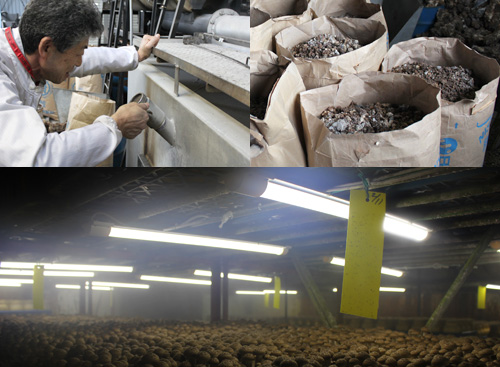 (Left) Mr. Sakurai spent a lot of time staring through the little window, as shown, so you can clearly see his palm print on the desk. A sign of his hard work. (Right) The hardened lava like chunks are ashes that are left after the mushroom beds are burned. These ashes are then taken to the compost center in town and turned into compost after being combined with leftover food products, livestock manure, and used mushroom beds from other farms. (Below) LED lights make the mushrooms grow. "Florescent lights broke really easily. People are turning to LED lights now, not only because they save energy, but because this can help reduce risk of broken glass getting mixed in with the product" said Mr. Sakurai.
(Left) Mr. Sakurai spent a lot of time staring through the little window, as shown, so you can clearly see his palm print on the desk. A sign of his hard work. (Right) The hardened lava like chunks are ashes that are left after the mushroom beds are burned. These ashes are then taken to the compost center in town and turned into compost after being combined with leftover food products, livestock manure, and used mushroom beds from other farms. (Below) LED lights make the mushrooms grow. "Florescent lights broke really easily. People are turning to LED lights now, not only because they save energy, but because this can help reduce risk of broken glass getting mixed in with the product" said Mr. Sakurai.
Mr. Sakurai, who has had 10 years of experience working at a manufacturer of audio devices, really loves new equipment like these, much to his wife's dismay. Both Mr. Kojima from Sangitei and Mr. Sakurai are pioneer energy savers. They try out many things with the new equipment, and I got the sense that they truly love developing new systems.
目次へ移動 The spirit of "community farming" is key to being pioneers of natural energy
I went and spoke to Mr. Hiroshi Ogawa, who works at the global warming division of the Iida city local government office. The forward-thinking activities to install solar power generation systems with the cooperation of the public also became a large turning point for the city of Iida. The reason why local credit unions agreed to finance the "Zero Yen System" from the beginning was because "the financial institutions saw potential for growth of this new type of natural energy business."
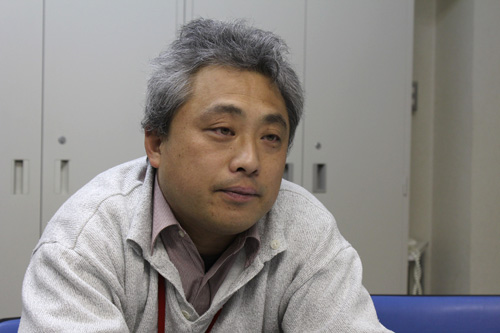 "We want to continue to work closely with Ohisama Shinpo, not only on solar power generation, but on projects that affect the entire region" said Mr. Ogawa.
"We want to continue to work closely with Ohisama Shinpo, not only on solar power generation, but on projects that affect the entire region" said Mr. Ogawa.
After solar power generation, the hottest topic in Iida at the moment is small-scale hydroelectric generation. This refers to hydroelectric generation under 10,000KW. In anticipation of the implementation of the Feed-in Tariff, which will apply to solar energy as well as other types of natural energy, in July 2012 and the movement to relax legislation, substantive research is being carried out in the village of Ozawagawa in the Kamimura region located in the southeastern part of Iida on behalf of the Ministry of Internal Affairs and Communication's project to promote the "Green Decentralization Reforms". Ozawagawa gets a stable flow of water, and you can also gather data on the depletion of water due to water withdrawal. Moreover, there is enough space in the surrounding area to build an energy plant, so it fulfills the necessary criteria for small-scale hydroelectric generation. This year, detailed flow measurements will be taken to find out whether power can really be generated in this area. And in order to realize this project, discussions with villagers have begun to be held since last year.
Kamimura is located at an altitude of approximately 1,000 meters. Depopulation is a grave issue for this region, but the small-scale hydroelectric generation may help revive the region. The revenue from the Feed-in Tariff will be added to the cash flow and with financing from financial institutions and investment from the public within and outside the region, they plan to allocate the revenue from the project to various issues the region faces. The city aims to create such a community-based grass-roots program.
From the aspect of conservation of the national territory, energy generation projects to be built on rivers and streams, which are important national resources, must not only serve public interest, but it must also be profitable. This is one of the key reasons why the government is involved. Rivers and streams are, in principle, under the government's jurisdiction, so they are subject to the River Act, legislation on forests and the energy business, and many other laws involving the various ministries and agencies as well as electric power companies. Unlike solar panels, which only involve individual buildings, the road ahead is quite a bit more treacherous, but that is why Mr. Ogawa is thinking positively. He said, "It's a natural energy that has the potential of getting everyone in the region involved."
Iida City has set an ambitious goal. As a model eco-conscious city, it aims to reduce greenhouse gas emissions by 70% by the year 2050 (in comparison to 2005 levels). This roadmap was drafted in 2011.
A story that depicts what life may be like 30 years from now is introduced on the brochure created by the city of Iida. It goes like this:
Mr. and Mrs. A, who are 80 years old, live in a cooperative house* run on sunlight and biomass. As you can see from the availability of demand responsive transport, the impact on the environment of many aspects of people's lives like transport is minimal. Their son and his family are living in a different cooperative house designed for younger people. He mainly works from home, but goes to the headquarters on the maglev (magnetic levitation) bullet train once a week. Many people come to visit Iida and its environmental researchers, engineers, and education specialists including interns and eco-tourists.
*Residents pitch in to purchase land, create a building consortium, and design and build a house together.
Mr. Ogawa explained, "We don't simply want to talk about constant economic growth. We want to promote a way of life that offers great environmental value-added, to emphasize the importance of unity to attract new settlers and encourage communication and interaction between residents. We hope that people will be able to imagine a life where the benefits of being part of a united community as well as quantitative objectives will encourage people to create new communities." The name Iida comes from "community farms", whereby people help one another sharing the hardships of farming. I thought this name was very becoming of a region that wants to become a leading region for the development of new communities with new values.
目次へ移動 Making the cash flow and hopes "visible" with social business
Having conducted these interviews, I realized that each person's hopes, from Mr. Hara to Mr. Ogawa, are on the same plane, forming one straight line. This movement, which began with the installation of 3KW solar panels purchased with donations, has expanded to 162 locations in just 5 years, and the vision has now spread to an eco town that also incorporates biomass and small-scale hydroelectric generation. Mr. Hara said that he "never dreamt that things would pan out the way they did."
If there are around 50,000 homes in the Minami Shinshu area, there's still a long ways to go for solar panel installation, but I feel that making the cash flow "visible" with public investment was quite significant. "Toyota's business began 70 years ago with 1 car. I look forward to Ohisama Shinpo Energy 70 years from now"Mr. Hara said with a big grin.
After the Great East Japan Earthquake, the demand for solar power generation systems has increased. There are many companies that are emerging into this market, but Mr. Hara has not changed his position. "There is a lot that large companies can't do. They can do things with scale, but they can't enter a market unless a certain level of profit can be expected. It's up to us to think of a good community-based approach. It's a social business. I think that is what is most important."
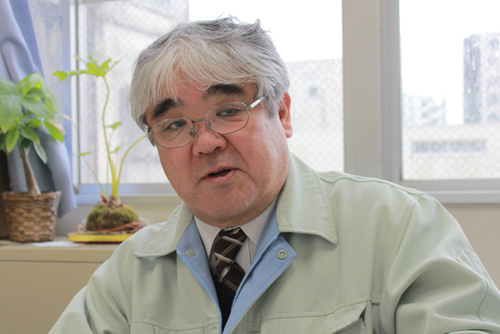 "Even if profits are small, we want to continue to work together with the people of the region as a social business," commented Mr. Hara.
"Even if profits are small, we want to continue to work together with the people of the region as a social business," commented Mr. Hara.
Located in a mountainous area, Iida has rich forest resources. 84% of its land is covered by forests. Mr. Hara has his eyes on biomass. He describes it as being "the most dynamic". As part of its policies for supplying heat, the city has provided pellets created from scrap wood by the Nanshin Biomass Cooperative to schools and public facilities as fuel to heat stoves for 7 years now. Another initiative that the city has undertaken is the "lumberjack" project, which invites people who love wood-burning stoves to spend time in the forest cutting firewood. Many people are involved in cutting down wood and separating them into building materials and non-building materials, so this creates job opportunities. Wood from thinning forests weren't put to good use in the past, but by exporting them, a distribution channel has been created, and resources from forest can be reused. Use of natural energy isn't only beneficial for human beings.
People may think that natural energy is rather expensive, but it seemed as though the public is being asked to cultivate the ability to recognize the value of forests and rivers from a multifaceted perspective rather than simply based on whether it is cheap or expensive. What do we mean by wealth in the first place? I found myself asking this question. What left a strong impression was that Kamimura, which would be considered a marginal village, was selected as the optimal location for small-scale hydroelectric generation.If we look at the same village from the perspective of natural energy, mountainous regions such as Iida are truly an energy gold mine. The map of Japan looks completely different if you think about it this way.
Mr. Hara mentioned repeatedly that it is important to make the business "visible". It all began when Mr. Hara gathered up his courage and expressed his hopes and dreams. One after another, other people voiced their agreement, bonded together, and created this movement that has changed the future.This is truly a wonderful example of public power. It's on a completely different spectrum as nuclear energy, which is not very accessible to the public, and a lot of the information lacks transparency. By making each person's hopes for changing the situation and the cash flow "visible", energy can be placed once again in the hands of the public, the community. The people of Iida, who are moving forward steadfastly with this hope in mind, will surely give people across Japan courage.
Related URL
Ohisama Shinpo Energy (Japanese Only)
http://www.ohisama-energy.co.jp/
Mitsuko Iwai Biography
She has worked for a local museum/news paper publisher before she became a freelance writer. In 2002, she became involved in publishing a book of record of government's cultural programs and became intrigued with the ideas and lifestyles in the various regions that are passed down from one generation to the next. In 2004, she published the first issue of "Satomi Tsushin" which focuses on the theme, fixed-point observation of farms and farmers. She is also an as an editorial staff for the Earth News for the Think the Earth Project. She currently lives in Takasaki.
Reported and orginal Japanese text written by: Mitsuko Iwai
Photographs:Toshi Inomata
Translated by: Yuri Morikawa (oxygen inc.)
Edited by: Soichi Ueda (Think the Earth)















